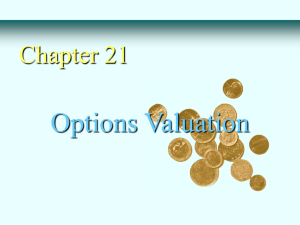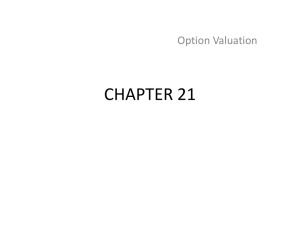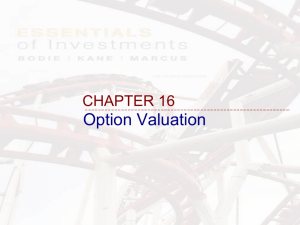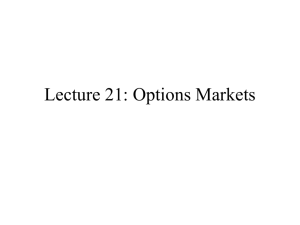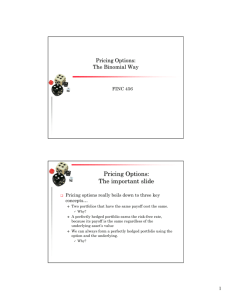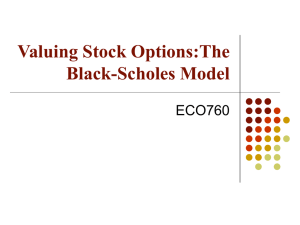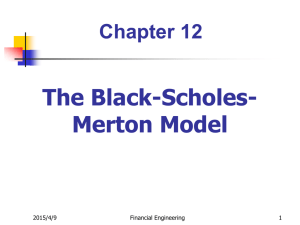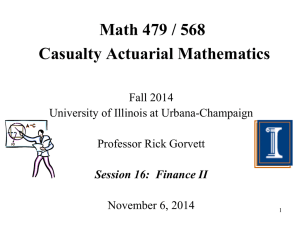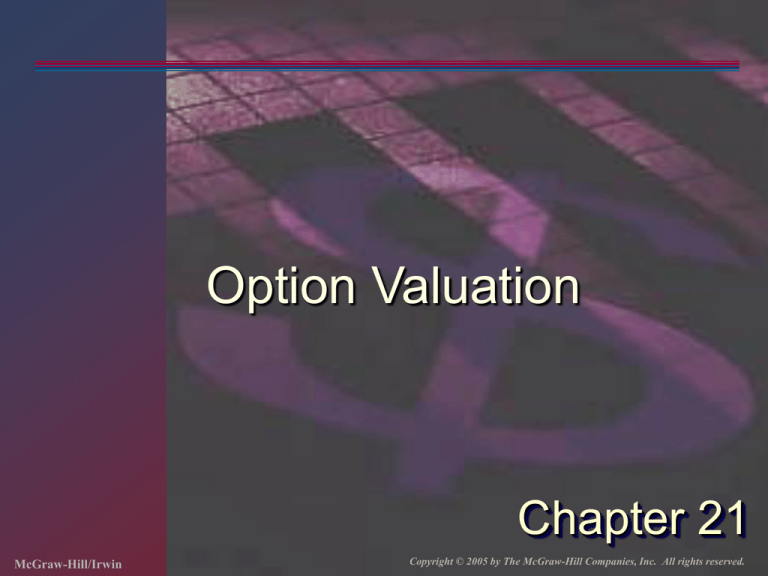
Option Valuation
Chapter 21
McGraw-Hill/Irwin
Copyright © 2005 by The McGraw-Hill Companies, Inc. All rights reserved.
Option Values
Intrinsic value - profit that could be
made if the option was immediately
exercised.
Call: stock price - exercise price
Put: exercise price - stock price
Time value - the difference between the
option price and the intrinsic value.
21-2
Time Value of Options: Call
Option
value
Value of Call
Intrinsic Value
Time value
X
Stock Price
21-3
Factors Influencing Option Values: Calls
Factor
value
Stock price
Exercise price
Volatility of stock price
Time to expiration
Interest rate
Dividend Rate
Effect on
increases
decreases
increases
increases
increases
decreases
21-4
Restrictions on Option Value: Call
Value cannot be negative
Value cannot exceed the stock value
Value of the call must be greater than
the value of levered equity
C > S0 - ( X + D ) / ( 1 + Rf )T
C > S0 - PV ( X ) - PV ( D )
21-5
Allowable Range for Call
Call Value
Lower Bound
= S0 - PV (X) - PV (D)
S0
PV (X) + PV (D)
21-6
Binomial Option Pricing: Text Example
200
100
75
C
50
Stock Price
0
Call Option Value
X = 125
21-7
Binomial Option Pricing: Text Example
Alternative Portfolio
Buy 1 share of stock at $100
Borrow $46.30 (8% Rate)
Net outlay $53.70
Payoff
Value of Stock 50 200
Repay loan
- 50 -50
Net Payoff
0 150
150
53.70
0
Payoff Structure
is exactly 2 times
the Call
21-8
Binomial Option Pricing: Text Example
150
53.70
75
C
0
0
2C = $53.70
C = $26.85
21-9
Replication of Payoffs and Option Values
Alternative Portfolio - one share of stock
and 2 calls written (X = 125)
Portfolio is perfectly hedged
Stock Value
50
200
Call Obligation
0
-150
Net payoff
50
50
Hence 100 - 2C = 46.30 or C = 26.85
21-10
Generalizing the Two-State Approach
Assume that we can break the year into two sixmonth segments.
In each six-month segment the stock could
increase by 10% or decrease by 5%.
Assume the stock is initially selling at 100.
Possible outcomes:
Increase by 10% twice
Decrease by 5% twice
Increase once and decrease once (2 paths).
21-11
Generalizing the Two-State Approach
121
110
104.50
100
95
90.25
21-12
Expanding to Consider Three Intervals
Assume that we can break the year into
three intervals.
For each interval the stock could
increase by 5% or decrease by 3%.
Assume the stock is initially selling at
100.
21-13
Expanding to Consider Three Intervals
S+++
S++
S++-
S+
S+-
S
S+-S-
S-S---
21-14
Possible Outcomes with Three Intervals
Event
Probability
Stock Price
3 up
1/8
100 (1.05)3
=115.76
2 up 1 down
3/8
100 (1.05)2 (.97)
=106.94
1 up 2 down
3/8
100 (1.05) (.97)2
= 98.79
3 down
1/8
100 (.97)3
= 91.27
21-15
Black-Scholes Option Valuation
Co = SoN(d1) - Xe-rTN(d2)
d1 = [ln(So/X) + (r + 2/2)T] / (T1/2)
d2 = d1 + (T1/2)
where
Co = Current call option value.
So = Current stock price
N(d) = probability that a random draw from a
normal dist. will be less than d.
21-16
Black-Scholes Option Valuation
X = Exercise price
e = 2.71828, the base of the natural log
r = Risk-free interest rate (annualizes
continuously compounded with the same
maturity as the option)
T = time to maturity of the option in years
ln = Natural log function
Standard deviation of annualized cont.
compounded rate of return on the stock
21-17
Call Option Example
So = 100
X = 95
r = .10
T = .25 (quarter)
= .50
d1 = [ln(100/95) + (.10+(5 2/2))] /
(5 .251/2)
= .43
d2 = .43 + ((5.251/2)
= .18
21-18
Probabilities from Normal Dist
N (.43) = .6664
Table 17.2
d
N(d)
.42
.6628
.43
.6664 Interpolation
.44
.6700
21-19
Probabilities from Normal Dist.
N (.18) = .5714
Table 17.2
d
N(d)
.16
.5636
.18
.5714
.20
.5793
21-20
Call Option Value
Co = SoN(d1) - Xe-rTN(d2)
Co = 100 X .6664 - 95 e- .10 X .25 X .5714
Co = 13.70
Implied Volatility
Using Black-Scholes and the actual price
of the option, solve for volatility.
Is the implied volatility consistent with the
stock?
21-21
Put Value Using Black-Scholes
P = Xe-rT [1-N(d2)] - S0 [1-N(d1)]
Using the sample call data
S = 100 r = .10 X = 95 g = .5 T = .25
95e-10x.25(1-.5714)-100(1-.6664) = 6.35
21-22
Put Option Valuation: Using Put-Call Parity
P = C + PV (X) - So
= C + Xe-rT - So
Using the example data
C = 13.70
X = 95 S = 100
r = .10
T = .25
P = 13.70 + 95 e -.10 X .25 - 100
P = 6.35
21-23
Black-Scholes Model with Dividends
The call option formula applies to stocks
that pay dividends.
One approach is to replace the stock
price with a dividend adjusted stock
price.
Replace S0 with S0 - PV (Dividends)
21-24
Using the Black-Scholes Formula
Hedging: Hedge ratio or delta
The number of stocks required to hedge against
the price risk of holding one option.
Call = N (d1)
Put = N (d1) - 1
Option Elasticity
Percentage change in the option’s value
given a 1% change in the value of the
underlying stock.
21-25
Portfolio Insurance
Buying Puts - results in downside
protection with unlimited upside
potential.
Limitations
Tracking errors if indexes are used for the
puts.
Maturity of puts may be too short.
Hedge ratios or deltas change as stock
values change.
21-26
Hedging On Mispriced Options
Option value is positively related to volatility:
If an investor believes that the volatility that is
implied in an option’s price is too low, a
profitable trade is possible.
Profit must be hedged against a decline in the
value of the stock.
Performance depends on option price relative
to the implied volatility.
21-27
Hedging and Delta
The appropriate hedge will depend on the
delta.
Recall the delta is the change in the value
of the option relative to the change in
the value of the stock.
Delta =
Change in the value of the option
Change of the value of the stock
21-28
Mispriced Option: Text Example
Implied volatility
= 33%
Investor believes volatility should = 35%
Option maturity
= 60 days
Put price P
= $4.495
Exercise price and stock price
= $90
Risk-free rate r
= 4%
Delta
= -.453
21-29
Hedged Put Portfolio
Cost to establish the hedged position
1000 put options at $4.495 / option
$ 4,495
453 shares at $90 / share
40,770
Total outlay
45,265
21-30
Profit Position on Hedged Put Portfolio
Value of put option: implied vol. = 35%
Stock Price
Put Price
Profit (loss) for each put
89
90
91
$5.254
$4.785
$4.347
.759
.290
(.148)
Value of and profit on hedged portfolio
Stock Price
89
90
91
Value of 1,000 puts
$ 5,254
$ 4,785
$ 4,347
Value of 453 shares
40,317
40,770
41,223
Total
45,571
45,555
5,570
Profit
306
290
305
21-31

